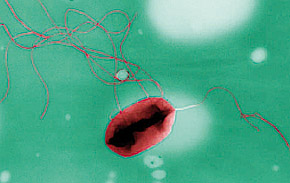M













The role of European Union Reference Laboratories in food safety crisis
The experience of the EU-RL for Escherichia coli during the recent outbreak of E.coli O104:H4 infections
A.Caprioli (1), S. Morabito (1), K. De Smet (2)
(1) EU Reference Laboratory for Escherichia coli, Dipartimento di Sanità Pubblica Veterinaria e Sicurezza Alimentare, Istituto Superiore di Sanità, Viale Regina Elena 299, 00161 Rome, Italy
(2) European Commission, Health and Consumers Directorate-General, 1049 Brussels, Belgium
NB: The views or positions expressed in this text correspond to the authors and are not, and cannot be regarded as representing the position, the views or the policy of the European Commission.
A.Caprioli, S. Morabito, K. De Smet (2012). The role of European Union Reference Laboratories in food safety crisis: The experience of the EU-RL for Escherichia coli during the recent outbreak of E.coli O104:H4 infections, EuroReference, No. 6, ER06-12P01.
http://www.ansespro.fr/euroreference/numero6/PN20I0.htm

The EU Reference Laboratories (EU-RLs) are established and financed by the Directorate General for Health and Consumers (DG Sanco) to support the European Commission (EC) in facing specific food and feed hazards or specific animal diseases, according to the Regulation (EC) No. 882/2004 on official controls. When an EU-RL is established, the Member States (MS) have to designate their own National Reference Laboratory (NRL) on the same hazard, in order to create an EU laboratory network on that topic. The duties and functions of EU-RLs and NRLs are detailed in the Articles 32 and 33 of Reg. (EC) No. 882/2004, respectively. In practical terms, the EU-RLs duties involve: (1) developing reference analytical methods; (2) coordinating the application of such methods by the NRLs, in particular by organizing proficiency tests (PTs); (3) coordinating the network of NRLs, by providing them information on the advances in the field, reference materials, and specific training on analytical methods; and (4) providing scientific and technical assistance to the Commission, in particular to the DG Sanco, and the European Food Safety Authority (EFSA). The NRLs duties include the collaboration with the respective EU-RL, the coordination of the activities of the laboratories involved in official controls in their own country, including the organization of PTs, the dissemination of the information received from the EU-RL, and the scientific and technical assistance to their Authorities. If the resulting laboratory networks comply with those duties, the analytical methods, the reference materials, and the PTs are transferred by the EU-RLs to the NRLs and by the NRls to the local laboratories involved in official controls. The final aim of these activities is that any foodstuff produced or imported in any MS of the EU is tested using the same state-of-art methods and with comparable levels of proficiency. The added value of such networks can be particularly important in food safety crisis involving different MS, when testing food with standardized, rapid and reliable methods is essential to provide the competent authorities with the data needed to plan appropriate control measures and to inform correctly the consumers.
The aim of this note is to describe the experience of the EU-RL for Escherichia coli during the recent outbreak of E.coli O104:H4 infections occurred in Europe and to discuss on how the activities carried out by our network of E. coli reference laboratories in the previous years may have contributed in terms of EU preparedness to face the crisis.
The EU-RL for E. coli
Verocytotoxin (VT)-producing Escherichia coli (VTEC) infections are a major public health concern, because of the severe illnesses that they can cause, such as hemorrhagic colitis and hemolytic uremic syndrome (HUS), and the large number of outbreaks occurring all over the world (Caprioli et al., 2005). Due to this public health relevance, VTEC infections have been included in the list of zoonoses that will receive priority in monitoring schemes according to the Directive 2003/99/EC, and the EC established an EU-RL for VTEC in 2006.
The EU-RL VTEC is housed within the Istituto Superiore di Sanità (ISS) in Rome and its characteristics and activities have already been described in this Journal (Caprioli et al., 2010). The network of NRLs coordinated by the EU-RL VTEC includes all the EU Member States and also laboratories of other European countries.
The outbreak of E.coli O104:H4 and its possible sources
Between May and June 2011, a severe outbreak of bloody diarrhea and HUS associated with infection with an unusual VTEC serotype (E. coli O104:H4) occurred in Germany. Numerous cases were reported in other European countries, but most of them had acquired the infection by traveling to Germany. According to the European Centre for Disease Control and Prevention (ECDC), there were more than 4,000 cases, with 46 deaths and 786 cases of HUS.
The first epidemiologic studies indicated the consumption of mixed salads as the main risk factor for acquiring the infection, and preliminary microbiologic analyses indicated cucumbers imported from Spain as the possible source. However, further analyses did not confirm the presence of the outbreak strain in the cucumbers. At the beginning of June, further epidemiologic studies indicated that the cause of the outbreak was the consumption of sprouts produced by a single German producer. However, all the microbiologic investigations conducted by the German authorities on the sprouts, the seeds used for sprouting, and the plant structures failed to isolate the outbreak strain (Frank et al. 2011).
On 24 June, a distinct outbreak due to a VTEC O104:H4 isolate similar to the German epidemic strain was reported in France (Gault et al. 2011). The episode involved 16 adult cases and no direct connection with Germany was detected. However, patients had participated in a school party where they ate raw sprouts grown in the school itself by the children. This second outbreak strongly supported the hypothesis that sprouts were the source of the outbreak. The only sprout species grown by both the French school and the German producer was fenugreek, and tracing back analyses coordinated by EFSA indicated an Egyptian farm as the common origin of the seeds (EFSA, 2011a).
The outbreak E. coli strain
The outbreak strain belonged to the uncommon serotype O104:H4 and, surprisingly, did not possess the eae gene, a genetic marker of the “attaching-effacing” mechanism of adhesion to the intestinal mucosa which is present in the VTEC serogroups most associated with severe human infections. However, VTEC O104:H4 showed the enteroaggregative adhesion, typical of another group of diarrheagenic E.coli (Scheutz. et al. 2011). The genome sequencing confirmed that the outbreak strain was an enteroaggregative E.coli (EAEC) that had acquired a VT converting phage (Mellmann et al. 2011). This unusual combination of virulence genes had already been described in a strain of VTEC O111 isolated from an outbreak of HUS (Morabito et al. 1998) and could explain the high virulence of VTEC O104:H4.
The EU-RL for Escherichia coli was thoroughly involved in the recent outbreak of E.coli O104:H4 infections occurred in Europe. Based on the activities carried out in the previous year, a method for the detection of the outbreak strain in food was rapidly developed and distributed to the NRL network, together with appropriate reference materials. The EU-RL also performed laboratory testing of different types of samples and organized an inter-laboratory study on the detection of VTEC in seeds used for the production of sprouts. During the entire period of the crisis, it provided continuous scientific and technical support to DG SANCO. Moreover, the EU-RL participated in the inspection mission to Egypt carried out by the Food and Veterinary Office and took part in several working groups and initiatives established by EFSA and/or ECDC. The experience of the E.coli O104:H4 outbreak confirmed that the activities of EU-RLs can provide an important contribution to the EC preparedness to face food safety crisis.
Point of view
The role of European Union Reference Laboratories in food safety crisis
The experience of the EU-RL for Escherichia coli during the recent outbreak of E.coli O104:H4 infections
>>Page 1
>>Page 2





